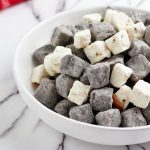I absolutely adore making Crème Brûlée! It’s a classic and luxurious dessert that never fails to impress. The creamy custard base is infused with vanilla, giving it a heavenly aroma. The real magic happens when you caramelize the sugar on top with a blowtorch, creating a crisp, caramelized crust.

The contrast between the silky smooth custard and the satisfying crack of the burnt sugar is what makes this dessert truly irresistible. It’s a simple yet elegant dessert that is sure to impress your guests.
Ingredients Needed for This Recipe
- 1 tbsp vanilla extract or 1 vanilla bean or 1 tbsp vanilla bean paste
- 5 egg yolks
- ½ cup sugar
- Pinch of salt
- 2 tbsp bourbon optional
- 2 cup of whipping cream 35% fat content
- Extra sugar to caramelize
Preparing the Custard
Step-by-step guide to preparing the custard
- Put the egg yolks into a big bowl or container. Include the appropriate amount of sugar (depending on the size of the baking dishes), vanilla extract, a little bit of salt, and bourbon (if desired), then mix them all together until a light-colored consistency is achieved.
- Combine the cream with the whisk and mix together. Stir until all the sugar has completely dissolved.
- You have the choice to put the custard mixture in a saucepan and gently warm it over medium heat, continuously whisking until it becomes warm and starts to release steam. The sugar should also completely dissolve. Please refer to the recipe notes for more information.
- The custard mixture might have bubbles on top. Cover it and let it sit, so the bubbles can go away. You can also stir gently to get rid of some of the bubbles.
- Divide the custard into six half-pint jars and seal them with the lids. Afterward, slightly loosen the lids to prevent excessive pressure and ensure the jars are not tightly closed (for more information, please refer to the provided post for instructions).
- Pour hot tap water into your sous vide container. Connect your sous vide circulator and adjust the temperature to 179°F – 181°F / 82°C – 83°C. Begin the sous vide process.
- Carefully place the jars into the water, which will enable them to reach the desired temperature together with the water.
- Once the circulator has reached the desired temperature, begin counting the cooking time for one hour.
- After one hour, take out the jars from the water container and fasten the lids by using a cloth napkin to provide a better grip since the jar and lid will be extremely hot at this point.
- Allow the custards to cool entirely until they reach the temperature of the room.
- Move the jars to the refrigerator and allow them to cool down for the duration of the night.
- When you are prepared to serve them, you may need to carefully use a spoon to remove the lids from the jars in order to break the seal.
Tips for achieving a smooth and silky texture
- Be sure to whisk the egg yolks and sugar until well combined to ensure proper incorporation.
- Straining the custard mixture helps to remove any lumps or air bubbles, resulting in a smoother texture.
- Avoid overcooking the custard by checking for a slight jiggle in the center. Overcooking can result in a rubbery texture.
- Let the custards cool to room temperature before refrigerating them. This helps to set the custard and allows the flavors to develop.
- Just before serving, sprinkle 1 tablespoon of granulated sugar evenly over the top of each custard and caramelize it using a kitchen torch. The caramelized sugar adds a delicious crunch to the silky custard.
Preparing the Sugar Crust
There are two popular techniques to caramelize the sugar on top of your Crème Brûlée: using a kitchen torch or your oven’s broiler. Both methods can achieve that perfect golden-brown crust, so choose the one that suits you best.
Torch technique: If you have a kitchen torch, this method is quick, easy, and gives you more control over the caramelization process. Start by sprinkling a thin, even layer of granulated sugar on top of each custard-filled ramekin. Hold the torch about 2-3 inches away from the surface and move it in a circular motion, heating the sugar until it melts and turns a beautiful golden brown. Be careful not to hold the flame too close for too long to avoid burning the sugar or overheating the custard.
Broiler technique: If you don’t have a kitchen torch, your oven’s broiler can also do the trick. Adjust your oven rack to the highest position and preheat the broiler on high. Sprinkle the sugar evenly on top of each custard-filled ramekin. Place the ramekins on a baking sheet and move them under the broiler. Keep a close eye on them and rotate the baking sheet if necessary to promote even browning. Once the sugar has caramelized and achieved the desired color, remove the ramekins from the oven and allow them to cool for a few minutes before serving.
Variations and Flavor Combinations
Creative Twists to Traditional Crème Brûlée
Chocolate Crème Brûlée: Incorporate rich and indulgent chocolate flavors into your custard by adding cocoa powder or melted chocolate before baking. The result is a decadent dessert that chocolate lovers won’t be able to resist.
Fruit Infused Crème Brûlée: Infuse your custard with the flavors of your favorite fruits, such as lemon, raspberry, or passion fruit. Simply add zest, juice, or puree to the custard mixture before baking to create a refreshing and tangy twist.
Spiced Crème Brûlée: Add warmth and depth to your Crème Brûlée by incorporating spices like cinnamon, nutmeg, or cardamom. These aromatic additions will elevate the flavors and give your dessert a cozy twist.
Experimenting with Different Flavors
Salted Caramel Crème Brûlée: Combine the sweetness of caramel with a hint of saltiness for a delightful balance of flavors. Drizzle some salted caramel sauce on top of the custard before adding the sugar crust, or sprinkle a bit of flaky sea salt on the caramelized sugar for that extra touch.
Vanilla Bean Crème Brûlée: Stick to the classic flavors but elevate them by using real vanilla beans. Scrape the seeds from a vanilla bean pod and infuse them in the custard mixture during the heating process. The tiny black specks will add a burst of vanilla flavor that can’t be mimicked by extracts.
Coconut Crème Brûlée: Add a tropical twist to your dessert by substituting some of the heavy cream with coconut milk. This will impart a subtle coconut flavor to the custard, perfect for those who enjoy a taste of the tropics.
Common Mistakes to Avoid
Overcooking the Custard: It’s essential to keep a close eye on the custard while it’s baking. Overcooking can result in a curdled texture and a loss of the creamy consistency that makes Crème Brûlée so delightful. Remove the custard from the oven when it is set but still slightly jiggly in the center.
Not Letting the Custard Chill: After baking, it’s crucial to allow the custard to cool completely in the refrigerator. This step ensures that the custard sets properly and allows the flavors to develop fully.
Rushing the Caramelization: When it’s time to caramelize the sugar crust, patience is key. Take your time to evenly coat the surface of the custard with a thin layer of sugar, using a kitchen torch or broiler. Rushing this step can result in uneven browning or burnt spots.
Serving the Dessert Too Early: Give the caramelized sugar a few minutes to harden before serving. This will allow the sugar crust to develop that satisfying crackling texture, adding to the overall experience of enjoying Crème Brûlée.
More Desert Recipes
If you like this creme brulee recipe, here are some other desert recipes you might like:
- Simple Peanut Butter Mousse
- Muddy Buddies Cookies and Cream
- Pineapple Pretzel Salad
- Cranberry Jello Salad

Faq About Crème Brûlée Recipe
What are the essential ingredients in a Crème Brûlée?
The basic ingredients for a Crème Brûlée include heavy cream, egg yolks, sugar, and vanilla extract. These ingredients form the rich custard base that is the heart of this dessert.
Can I use vanilla extract instead of vanilla beans?
Yes, you can substitute vanilla extract for vanilla beans. However, using real vanilla beans will impart a more intense and aromatic flavor to your Crème Brûlée. If you don’t have vanilla beans, you can scrape the seeds from the inside of a vanilla pod and add them to the custard mixture.
What is the purpose of the water bath?
A water bath, also known as a bain-marie, is used to create a gentle and even heat for the custard while it bakes. It helps prevent the custard from curdling or cracking. It also ensures a smooth and creamy texture in the final dessert.
Can I use a kitchen torch to caramelize the sugar crust?
Yes, using a kitchen torch is the most common method to caramelize the sugar crust on top of the Crème Brûlée. It allows for precise control and even browning of the sugar. However, if you don’t have a torch, you can also use a broiler to achieve the desired caramelization.
How long should I let the Crème Brûlée cool before serving?
After caramelizing the sugar crust, it’s best to let the Crème Brûlée sit for a few minutes to allow the sugar to harden. This will give you the perfect crack when you break through the caramelized layer with your spoon. The custard should be served at room temperature for the best taste and texture.

Easy Crème Brûlée
INGREDIENTS
- 1 tbsp vanilla extract or 1 vanilla bean or 1 tbsp vanilla bean paste
- 5 egg yolks
- ½ cup sugar
- Pinch of salt
- 2 tbsp bourbon optional
- 2 cup of whipping cream 35% fat content
- Extra sugar to caramelize
INSTRUCTIONS
- Put the egg yolks into a big bowl or container. Include the appropriate amount of sugar (depending on the size of the baking dishes), vanilla extract, a little bit of salt, and bourbon (if desired), then mix them all together until a light-colored consistency is achieved.
- Combine the cream with the whisk and mix together. Stir until all the sugar has completely dissolved.
- You have the choice to put the custard mixture in a saucepan and gently warm it over medium heat, continuously whisking until it becomes warm and starts to release steam. The sugar should also completely dissolve. Please refer to the recipe notes for more information.
- The custard mixture might have bubbles on top. Cover it and let it sit, so the bubbles can go away. You can also stir gently to get rid of some of the bubbles.
- Divide the custard into six half-pint jars and seal them with the lids. Afterward, slightly loosen the lids to prevent excessive pressure and ensure the jars are not tightly closed (for more information, please refer to the provided post for instructions).
- Pour hot tap water into your sous vide container. Connect your sous vide circulator and adjust the temperature to 179°F – 181°F / 82°C – 83°C. Begin the sous vide process.
- Carefully place the jars into the water, which will enable them to reach the desired temperature together with the water.
- Once the circulator has reached the desired temperature, begin counting the cooking time for one hour.
- After one hour, take out the jars from the water container and fasten the lids by using a cloth napkin to provide a better grip since the jar and lid will be extremely hot at this point.
- Allow the custards to cool entirely until they reach the temperature of the room.
- Move the jars to the refrigerator and allow them to cool down for the duration of the night.
- When you are prepared to serve them, you may need to carefully use a spoon to remove the lids from the jars in order to break the seal.




